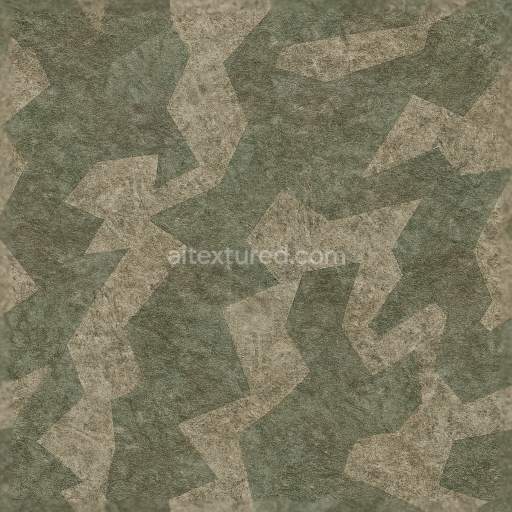This seamless 3D texture showcases a photorealistic granite stone splinter camouflage pattern meticulously crafted to replicate the complex composition of natural granite rock. The base substrate is mineral-rich granite, characterized by tightly interlocked quartz, feldspar, and mica grains that form an irregular, splintered surface. These mineral aggregates create a rugged, rough surface finish with subtle porosity and weathering effects that simulate realistic erosion and wear over time. The coloration features muted earth tones and faded pigments, resembling oxidized oxide layers and mineral stains that occur naturally in mountainous, rocky environments. This intricate composition is reflected in the PBR channels: the BaseColor/Albedo captures the detailed color variations and subtle discoloration of weathered stone, while the Normal map emphasizes the rough, uneven grain orientation and micro-relief of fractured splinters. The Roughness channel balances polished and matte areas to mimic natural surface finish variations, and the Ambient Occlusion enhances depth perception along cracks and crevices. Height/Displacement maps add realistic depth to the splintered texture, without any metallic properties, ensuring an authentic stone appearance.
Rendered in ultra-high 8K resolution, this granite stone splinter camo 3D texture is optimized for seamless tiling, making it ideal for large-scale terrain and environment assets requiring continuous, natural micro-variations. Its PBR design guarantees full compatibility with leading 3D software such as Blender, Unreal Engine, and Unity, allowing artists to integrate it effortlessly into their workflows. Whether used for rocky surfaces, camouflage armor elements, or rugged props, the texture’s detailed rough surface and realistic wear effects provide unparalleled authenticity and visual depth. For optimal results, it is recommended to adjust the UV scale carefully to maintain natural stone proportions and to fine-tune the roughness map to achieve the desired balance between matte and slightly polished surfaces, enhancing realism in varying lighting conditions.
How to Use These Seamless PBR Textures in Blender
This guide shows how to connect a full PBR texture set to Principled BSDF in Blender (Cycles or Eevee). Works with any of our seamless textures free download, including PBR PNG materials for Blender / Unreal / Unity.
What’s inside the download
*_albedo.png — Base Color (sRGB)*_normal.png — Normal map (Non-Color)*_roughness.png — Roughness (Non-Color)*_metallic.png — Metallic (Non-Color)*_ao.png — Ambient Occlusion (Non-Color)*_height.png — Height / Displacement (Non-Color)*_ORM.png — Packed map (R=AO, G=Roughness, B=Metallic, Non-Color)

Quick start (Node Wrangler, 30 seconds)
- Enable the addon: Edit → Preferences → Add-ons → Node Wrangler.
- Create a material and select the Principled BSDF node.
- Press Ctrl + Shift + T and select the maps
albedo, normal, roughness, metallic (skip height and ORM for now) → Open.
The addon wires Base Color, Normal (with a Normal Map node), Roughness, and Metallic automatically.
- Add AO and Height using the “Manual wiring” steps below (5 and 6).
Manual wiring (full control)
- Create a material (Material Properties → New) and open the Shader Editor.
- Add an Image Texture node for each map. Set Color Space:
- Albedo → sRGB
- AO, Roughness, Metallic, Normal, Height, ORM → Non-Color
- Connect to Principled BSDF:
albedo → Base Colorroughness → Roughnessmetallic → Metallic (for wood this often stays near 0)normal → Normal Map node (Type: Tangent Space) → Normal of Principled.
If details look “inverted”, enable Invert Y on the Normal Map node.
- Ambient Occlusion (AO):
- Add a MixRGB (or Mix Color) node in mode Multiply.
- Input A =
albedo, Input B = ao, Factor = 1.0.
- Output of Mix → Base Color of Principled (replaces the direct albedo connection).
- Height / Displacement:
Cycles — true displacement
- Material Properties → Settings → Displacement: Displacement and Bump.
- Add a Displacement node: connect
height → Height, set Midlevel = 0.5, Scale = 0.02–0.08 (tune to taste).
- Output of Displacement → Material Output → Displacement.
- Add geometry density (e.g., Subdivision Surface) so displacement has polygons to work with.
Eevee (or lightweight Cycles) — bump only
- Add a Bump node:
height → Height.
- Set Strength = 0.2–0.5, Distance = 0.05–0.1, and connect Normal output to Principled’s Normal.
Using the packed ORM texture (optional)
Instead of separate AO/Roughness/Metallic maps you can use the single *_ORM.png:
- Add one Image Texture (Non-Color) → Separate RGB (or Separate Color).
- R (red) → AO (use it in the Multiply node with albedo as above).
- G (green) → Roughness of Principled.
- B (blue) → Metallic of Principled.
UVs & seamless tiling
- These textures are seamless. If your mesh has no UVs, go to UV Editing → Smart UV Project.
- For scale/repeat, add Texture Coordinate (UV) → Mapping and plug it into all texture nodes.
Increase Mapping → Scale (e.g., 2/2/2) to tile more densely.
Recommended starter values
- Normal Map Strength: 0.5–1.0
- Bump Strength: ~0.3
- Displacement Scale (Cycles): ~0.03
Common pitfalls
- Wrong Color Space (normals/roughness/etc. must be Non-Color).
- “Inverted” details → enable Invert Y on the Normal Map node.
- Over-strong relief → lower Displacement Scale or Bump Strength.
Example: Download Wood Textures and instantly apply parquet or rustic planks inside Blender for architectural visualization.
To add the downloaded texture, go to Add — Texture — Image Texture.

Add a node and click the Open button.

Select the required texture on your hard drive and connect Color to Base Color.


